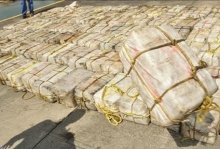 While Panamanian officials are hailing the largest cocaine seizure of the year as a major victory, it’s unlikely that improved interdiction rates will discourage traffickers from using Panama as a key trans-shipment hub for drugs.
While Panamanian officials are hailing the largest cocaine seizure of the year as a major victory, it’s unlikely that improved interdiction rates will discourage traffickers from using Panama as a key trans-shipment hub for drugs.
On July 4, Panama’s National Air and Sea Service (Servicio Nacional Aeronaval – SENAN) and the U.S. Coast Guard boarded a suspicious ship off the Carribbean coast of Panama. As it turned out, the ship – a Cook Island-registered vessel known as the “Fifita 500” – contained the largest amount of cocaine seized in a single operation by authorities so far this year: 1.8 metric tons of the drug.
In a statement made to the local press, Security Minister Jose Raul Mulino claimed this “truly massive capture” was a major blow to international drug traffickers. In reality, however, this seizure is but a drop in the bucket compared to the amount of cocaine shipments that pass through Panama on a regular basis. In 2010, Panamanian officials interdicted 75 tons of cocaine last year, more than any other country in Central America.
In many ways, however, the case serves as a microcosm for how Panama’s anti-drugs efforts are carried out. According to officials, the ship was likely destined for the United States, and all eight people on board were Colombian nationals. This fits perfectly with the profile of organized crime and drug trafficking in Panama.
As InSight Crime has reported, the country is often referred to as “the mouth of funnel,” because of its border with Colombia, the world’s largest producer of cocaine. And while there are certainly domestic drug traffickers in Panama, the U.S. State Department’s 2011 International Narcotics Control Strategy Report highlights foreign drug trafficking organizations as the major actors in smuggling cocaine into and out of the country.
On top of this, Panama is also a refuge for the Revolutionary Armed Forces of Colombia (Fuerzas Armadas Revolucionarias de Colombia – FARC), which operates camps in the isolated Darien region along the Colombian border. The FARC allegedly uses the dense jungle in this region as a holding center and logistics base for moving cocaine north. Although traditionally the government of Panama has adopted a lax attitude towards the guerrillas, this may be changing due to the recent adoption of a mutual border security pact with Colombia.
So while Mexican cartels push into Central America from the north, it is clear that Colombian groups are pressuring from the south and the region is finding itself squeezed between these transnational criminal syndicates.
The other way in which the “Fifita 500” seizure mirrors larger power dynamics within the region’s war on drugs is the degree of U.S. involvement. Mulino took great pains to emphasize the high level of coordination between Panamanian police and U.S. authorities in the operation. Panama has a long tradition of security cooperation with the U.S., a fact which made headlines recently with the release of a 2008 United States diplomatic cable obtained by Wikileaks.
The cable, entitled “Panamanian Security Cooperation: Irreplaceable?” reveals a secret agreement between the governments of Panama and the U.S. which gives license to American officials to carry out a wide array of counternarcotics operations on Panamanian territory. Among other things, the agreement allows the U.S. to listen to the phone calls of drug trafficking organizations, make unilateral seizures without Panamanian officials, conduct aerial surveillance for counternarcotics purposes, and board Panamanian-registered ships in international waters.
The last matter is particularly controversial, as one-third of all ships in the world are registered in Panama, which means that the U.S. has the right to board a third of all private vessels on the planet, even in waters outside of U.S. territory. Regardless, evidence from neighboring Costa Rican officials suggests that these measures may have been successful at discouraging traffickers from using Panama as a trans-shipment hub. More and more traffickers are using alternate land routes in Costa Rica, which could indicate that they are facing increased pressure in Panamanian waters.
Ultimately the July 4 seizure is far from a game changer in Panama’s anti-drug efforts. However, its triviality reveals much about the nature of the drug war on the Panamanian front.